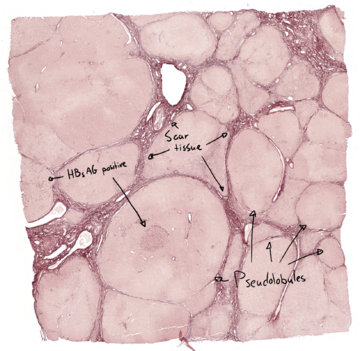7. HBs antigen positivism (Shikata orcein)
Staining: Shikata orcein

Organ: Liver
Description:
The liver parenchyme in this slide has been divided into “pseudolobules”. These pseudolobules don’t correspond to the normal liver lobules and have wildly varying sizes. The pseudolobules are surrounded by scar tissue.
In two of the pseudolobules there are hepatocytes which are HBsAG positive. Their morphology is called “ground-glass hepatocytes”.
Diagnosis: HBs antigen positive chronic hepatitis with cirrhosis
Causes:
- Hepatitis B infection

Theory:
Normal orcein stains elastic fibres while Shikata orcein stains the hepatitis B surface antigen (HBsAg) as well. This staining is not used in clinical practice as serology is preferred instead.
Because hepatocytes are HBsAg positive (ground- glass morphology) can we be certain that this chronic hepatitis was caused by Hep B infection.
The extensive pseudolobule formation with scar tissue surrounding them is characteristic for fully mature cirrhosis.